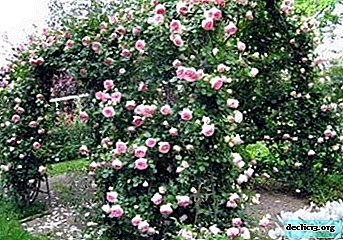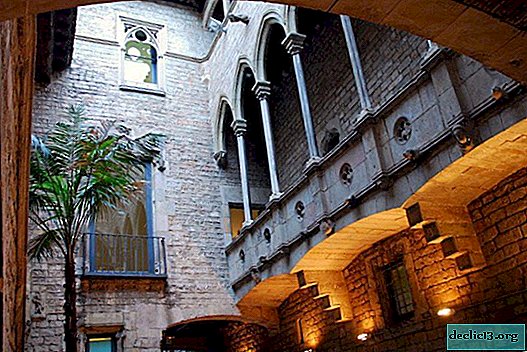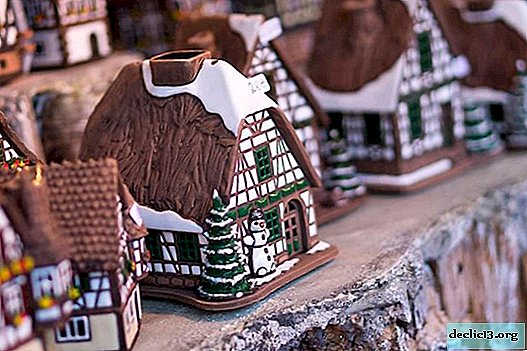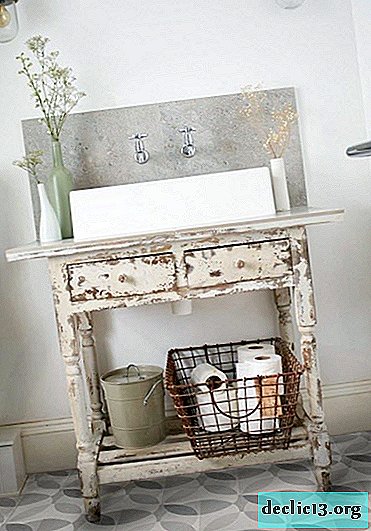Step-by-step instructions for making supports for climbing roses and garter plants for them. Photos and Care Tips

Roses are not only flower beds, but also weaving. It is wrong to think that it is only necessary to plant a rose, and she will find a place for weaving herself.
Beautiful long stems of the Queen of the Garden need support, they need reliable and no less beautiful support. This will allow the plant to rise beautifully in the garden and be in the spotlight.
Many gardeners let the rose up along the fence or walls of the house, but arches or special, beautiful supports made for this magnificent flower look much more spectacular.
What it is?
Support for climbing roses are decorative ornaments of the garden. They will not only decorate any land, but also save space, giving the garden a special atmosphere. Materials and shapes of supports are very diverse.
Why is it necessary?
Climbing roses grow very quickly, covering large areas of land, the facade of the house or the place where they were planted.
With the help of supports you can not only create a beautiful frame for a window, enter the garden or benches, but also save the plant from damage.Design Requirements
- Reliability and stability. The support should be dug well into the ground and fixed with metal stakes. A plastic support may not withstand the gravity of the flowers. Therefore, it is better if it is also made of metal.
- Decorative. The support should harmoniously fit into the landscape of the site.
- Matching Color Variety. A large stand will look strange in combination with small flowers. And vice versa.
- Thrift. In addition to store options, there are ways to make a support with your own hands.
- Environmental friendliness. This also applies to the safety of the flowers themselves.
- Simplicity in operation.
Next, we suggest that you familiarize yourself with step-by-step instructions for making your own supports - trellis, wooden posts, arches and pergolas, towers, wigwams, simple lattices and other types, as well as see their photos.
Step-by-step instruction: how to make a trellis with your own hands?

- Get a chain link with large cells.
As an option: you can stretch the mesh between any two supports at a distance of about a meter from each other.
- Determine the location for the structure. Roses are photophilous, and therefore the support should be sanctified by the sun, while not interfering with free movement in the garden, and not block other flowers or windows of the house.
- After digging a hole, dig in two-meter columns with a diameter of 15-20 cm, creating a square. They can be either metal or wooden.
- To paint the design.
- Pull the net over the posts, securing it with brackets and 100-150 mm nails.
- Instead of a grid, you can use thin wooden stakes with a diameter of 5 cm, stuffed with nails on a frame of beams 25 cm in diameter.
Do not put such a stand close to the wallso as not to disturb the air circulation around the plant.
We offer you to watch the video instruction for the manufacture of trellis:
Wooden pillar structure

Supports made of wooden pillars, especially if they are carved, will be an exquisite and unique attribute of a garden plot.
- The finished two-meter post must be buried securely in the ground. Concreting it is not necessary.
When working, you will need a shovel, saw, emery, hammer and nails per 100 mm.
- Soak the poles with a special composition of moisture with a brush.
- Apply waterproof paint.
- Fill transverse crossbars with a diameter of 5 cm onto the posts. Cells from the crossbars should be about 50 cm.
You can make a support in the form of a cone, whose legs are placed at a distance of half a meter from each other, and the top narrows with a cone. Such a stand will appeal not only to roses, but also to other climbing plants.
Making arches and pergolas

Pergola - a lattice on pillars in the form of a roof. It can serve as a gazebo.
- Dig metal or wooden poles, digging a hole, a depth of half a meter. Length, height and width are selected according to the type of plants.
For large roses, two-meter columns of 15-20 cm in diameter are suitable. For small species, half a meter is enough.
- To build a metal grid over the posts of thin rods of 1-2 cm in diameter to make large squares of 30 cm. This will allow the plant to grow unhindered. The rods are welded together and hoisted from above onto poles and securely fixed with 150 mm nails or 75 mm self-tapping screws.
Arches come in a variety of curved shapes.. They are designed for large varieties of climbing roses, which, as they grow, can reach the top. Arches are wonderful decorations for entrances and garden paths. They are forged and wooden. They are also dug into the ground and plants are planted at a distance of half a meter from the structure.
We offer to see the video instruction for the manufacture of the arch:
Step-by-step instruction: how to build a tower?

- Using a shovel, dig metal rails 50 cm high into the ground to a depth of half a meter so that the upper ends are joined together and the lower ends are widely spaced in different directions at a distance of 60 cm from each other. It turns out the view of the "Eiffel Tower". Such towers look especially beautiful, having an openwork structure.
- Plant roses without infringing them in space at a distance of 40 cm from the rooted bars.
- As you grow, tie the stems in the right direction and gradually direct them to the tower until they catch.
Do-it-yourself wigwam

This design is ideal for a garden plot that is decorated in an Indian style.
- Weave from willow or birch bark cone. As a rule, these are thin, but durable branches. They are joined together, forming a cavity inside and fixed with a rope or glue.
- The ideal height of the cone is 80-100 cm.
- The top of the cone should be with a sharp crown. The stems of roses will reach it, decorating the garden and braiding the cone in a circle.
How to make a simple lattice?

The easiest thing to do as a support for climbing roses is the grill. It can be either metal or wooden.
- Make horizontal and vertical crossbars with a diameter of 5-6 cm using a saw, emery and nails or self-tapping screws.
- Connect them together in the form of a lattice with 25-cm holes.
Wooden beams are sawn and stacked on top of each other in the form of a lattice, fixed with 70 mm screws or nails. Metal join by welding.
- Place the grill on two-meter poles dug at a distance of half a meter from each other or any other structures that are convenient to use. Secure with screws.
Other species
Supports for roses are different:
- You can build a wooden structure from any bars with a height of 40-60 cm, connecting them together with self-tapping screws of 70 mm, in shape resembling a tower, inside which there will be a small stand for the container from which the rose will grow.
- You can make a metal column of rods with a diameter of 5 cm from galvanized steel, which will last for many years. Such rods are welded together, forming a single whole.
- You can put a steel obelisk with a height of 80 cm from strong thin (up to 3 cm) pipes, which also have welding joints.
- You can make thin metal flip-flops on both sides of the paths by dug them 70 cm into the ground, creating a corridor of beautiful flowers. They should be quite long so that a person can pass under them unhindered. The length also depends on the width of the track over which they will be installed. As a rule, up to 5 meters.
How to decorate?
Supports for climbing roses, as a rule, do not need additional decorations, because they will be surrounded by already beautiful stems with bright lights of flowers of various colors. But while the stems have not yet completely encircled the entire structure, I want it to also have an aesthetic appearance. As ornaments, carved wood patterns, wrought-iron curls painted with bright waterproof paint, or garden figures on the edges of the structure, sold in specialized stores, are suitable.
How to tie a flower?
 Build the structure according to the size of the rose.
Build the structure according to the size of the rose.- Plant the plant at a distance of about 40 cm from the support or install the support at the same distance if the plant has already been planted.
- Keep an eye on the vines, waiting for a sufficient length, sufficient for the entanglement of the structure.
- Tie the stems to the structure with twine, applying a rose at an angle of 45 degrees.
- Fix the vine without tying it too tightly. The plant should be able to grow unhindered.
- Pruning vines at the age of three. To do this, cut the loop on the old shoots and at the base. Old stems are best removed with garden shears to make room for new, flowering plants.
We suggest watching a video on how to properly tie a rose:
Care
Roses for climbing roses need care. Be sure to carry out the processing of protective compounds that protect the structure from water. So that the supports do not become sources of infections for the plant, they must be periodically painted. Steel supports can last up to several tens of years, while wooden ones will have to be completely replaced in five years. At the same time, larch pillars will last twice as long as birch ones.
Interesting video
We offer you to watch a video about various supports for climbing roses:

 Build the structure according to the size of the rose.
Build the structure according to the size of the rose.















